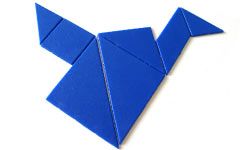Solving Sliding Puzzles
Sliding puzzles can be incredibly difficult to solve, as anyone who's tried can tell you. Mathematicians categorize sliders as PSPACE-complete, which is a measure of their mathematical complexity. Essentially, it means that even computers find it hard to come up with a solution [source: Hearn].
There is no universal rule that lets you solve a sliding puzzle, though many stumped players wish there were. As you work on a succession of sliders, you tend to develop an intuition about how to move pieces around the playing space. You'll get better, but each puzzle will still be a challenge.
Advertisement
The 15-type sliding puzzle, because all of its pieces are squares, is one of the most straightforward to solve. If you need some help, here are a few hints:
- Begin by maneuvering the 1 and 2 into their proper positions in the upper left corner.
- Position the 3 in the upper right corner.
- Maneuver the 4 under the 3
- Now slide the 3 to the left and the 4 up; the first row is done.
- Repeat this process with next row, leaving row above intact.
- Complete the puzzle by rearranging the pieces in the last two rows until they are in position.
- Sometimes it's easier to create "snakes" of pieces in the proper order rather than put them in their final position individually.
- If you're assembling a picture, study the design carefully before it's scrambled. It's harder to solve if you're not clear about the final outcome.
While you can find walkthrough solutions to some sliding puzzles on the Internet, most players aren't interested in getting help. The fun of sliders comes from the "eureka!" moment when you finally stumble on the solution. One general rule is that it can be helpful to concentrate on solving individual areas of the puzzle, while always keeping the larger picture in mind. You might start with one row or a particular corner.
The real secret that applies to solving every sliding puzzle ever invented can be summed up in one word: patience. Keep trying. The longer it takes, the more satisfying the solution.
Move on to read about a lot more fascinating info about sliding puzzles.
Sliding Puzzle FAQ
What is the trick to sliding puzzles?
What are those sliding puzzles called?
What is the game called where you move the blocks?
How do you solve a mosaic puzzle?
How can I turn a picture into a puzzle piece?
Related Articles
Sources
- Bogomolny, Alexander."Sam Loyd's Fifteen," cut-the-knot.org. (August 25, 2011) http://www.cut-the-knot.org/pythagoras/history15.shtml
- The Economist. "A hard, simple problem," December 2, 2004. (August 25, 2011) http://www.economist.com/node/3445734?story_id=3445734
- FreeSoft.com. "Sokoban game Stand-alone version." (August 25, 2011) http://www.365freesoft.com/sokoban.html
- Hearn, Robert. A. "The Complexity of Sliding-Block Puzzles and Plank Puzzles," mit.edu. (August 25, 2011) http://groups.csail.mit.edu/mac/users/bob/sliding-blocks.pdf
- logical-games.org. "Sliding Puzzles: Fifteen Puzzle." (August 25, 2011) http://fifteen.logical-games.org/
- Pegg, Ed. "Sliding Block Puzzles," Mathematical Association of America, December 13, 2004. (August 25, 2011) http://www.maa.org/editorial/mathgames/mathgames_12_13_04.html
- Rob'sPuzzlePage.com. "Sliding Block Puzzles/Sliding Piece Puzzles." (August 25, 2011) http://www.robspuzzlepage.com/sliding.htm
- Sharples, Barry. "Pennant Puzzle," Web Puzzle Compendium. (August 25, 2011) http://www.bsswebsite.me.uk/Puzzlewebsite/Pennantpuzzle/Pennantpuzzle.htm
- Slocum, Jerry. "Sam Loyd's Most Successful Hoax," indiana.edu. (August 25, 2011) http://www.indiana.edu/~liblilly/overview/puzzle_docs/Sam_Loyd_Successful_Hoax.pdf
- Slocum, Jerry and Dic Sonneveld. "The 15 Puzzle: How it Drove the World Crazy," AT&T Shannon Research Laboratory. (August 25, 2011) http://www2.research.att.com/~aarcher/Research/15puzzle_book_rev.pdf
- Soft Qui Peut. "SBPSolver V1.6." (August 25, 2011) http://www.culand.ch/dev/SBPSolver.htm
- Storer, Jim. "Ma's Puzzle," brandeis.edu. (August 25, 2011) http://pages.cs.brandeis.edu/~storer/JimPuzzles/ZPAGES/zzzMasPuzzle.html
- thinkfun.com. "Rush Hour." (August 25, 2011) http://www.puzzles.com/products/rushhour.htm


